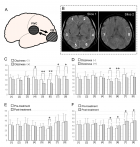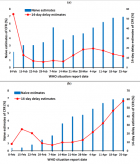Abstract
Mini Review
Post-stroke dizziness of visual-vestibular cortices origin
Nobuhiro Inoue* and Satoshi Goto
Published: 27 November, 2020 | Volume 4 - Issue 2 | Pages: 075-078
Many patients with chronic cerebrovascular diseases complain “dizziness”, which is a distortion of static gravitational orientation, or an erroneous perception of motion of the sufferer or of the environment. In the vestibular cortical system, the parieto-insular vestibular cortex (PIVC) serves as the core region having the strong interconnections with other vestibular cortical areas and the vestibular brainstem nuclei. By forming the reciprocal inhibitory interactions with the visual cortex (VISC), it also plays a pivotal role in a multisensory mechanism for self-motion perception. In a line of our studies on post-stroke patients, we found that there was a significant decrease in the cerebral blood flow in both the VISC and PIVC in the patients who suffered from dizziness. In this article, we provide a new concept that due to dysfunction of the visual-vestibular interaction loop, low cerebral blood perfusion in the PIVC and VISC might elicit post-stroke dizziness.
Read Full Article HTML DOI: 10.29328/journal.jnnd.1001038 Cite this Article Read Full Article PDF
Keywords:
Dizziness; Cerebral ischemia; Stroke; Visual-vestibular cortices; Cerebral blood flow
References
- Leigh RJ, Zee DS. The Neurology of Eye Movements. New York: Oxford University Press 1999.
- Baloh RW. The dizzy patient. Postgrad Med. 1999; 105: 161-164. PubMed: https://pubmed.ncbi.nlm.nih.gov/10026710/
- Tusa RJ. Dizziness. Med Clin North Amer. 2003; 87: 609-641. PubMed: https://pubmed.ncbi.nlm.nih.gov/12812406/
- Brandt T, Strupp M. General vestibular testing. Clin Neurophysiol. 2005; 116: 406-426. PubMed: https://pubmed.ncbi.nlm.nih.gov/15661119/
- Burt CW, Schapper SM. Ambulatory care visits to physician offices, hospital out-patient departments, and emergency departments. United States, 1999-2000. Vital Health Stats. 2004; 13: 161-714.
- Kerber KA, Brown D, Lisabeth, LD, Smith MA, Morgenstern JB. Stroke among patients with dizziness, vertigo, and imbalance in the emergency department. A population-based study. Stroke. 2006; 37: 2484-2487. PubMed: https://pubmed.ncbi.nlm.nih.gov/16946161/
- Penfield W, Jasper H. Epilepsy and the Functional Anatomy of the Human Brain. 1954.
- Grusser OJ, Pause M, Schreiter U. Neuronal response in the parieto-insular vestibular cortex of alert Java monkeys (Macaca fascicularis). (1990) In: Physiological and Pathological Aspects of Eye Movements. 251-270.
- Gruccer OJ, Pause M, Schreuter U. Localization and responses of neurons in the parieto-insular vestibular cortex of awake monkeys (Macaca fascicularis). J Physiol. 1990; 430: 537-557. PubMed: https://pubmed.ncbi.nlm.nih.gov/2086773/
- Guldin W, Grusser OJ. The anatomy of the vestibular cortices of primates. In: M. Collard, M. Jeannerord, Y. Christen (eds) Le cortex vestibulaire, Ipsen, Boulogne. 1996; 17-26.
- Wenzel R, Bartenstein P, Dieterich M, Danek A, Weindl A, et al. Deactivation of human visual cortex during involuntary ocular oscillations: A PET activation study. Brain. 1996; 119: 101-110. PubMed: https://pubmed.ncbi.nlm.nih.gov/8624674/
- Tiecks FP, Planck J, Harberl RL, Brandt T. Reduction in posterior cerebral artery blood flow velocity during caloric vestibular stimulation. J Cerebr Blood Flow Metab. 1996; 6: 1379-1382. PubMed: https://pubmed.ncbi.nlm.nih.gov/8898715/
- Brandt T, Bucher SF, Seelos KC, Dieterich M. Reciprocal inhibitory visual-vestibular interaction: Visual motion stimulation deactivates the parieto-insular vestibular cortex. Brain. 1998; 121: 1749-1758. PubMed: https://pubmed.ncbi.nlm.nih.gov/9762962/
- Ombergen AV, Heine L, Jillings S, Roberts RE, Jeurissen B, et al. Altered functional brain connectivity in patients with visually induced dizziness. NeuroImage: Clinical. 2017; 14: 538-545. PubMed: https://pubmed.ncbi.nlm.nih.gov/28331800/
- Inoue N, Fuyuta S. Cerebral blood flow in the visual and parieto-insular vestibular cortices in the patients after cerebral ischemia with or without dizziness. Int J Neuro Disord Interv. 2015; 1: 101-104.
- Inoue N, Harada M. Effect of ibudilast on non-specific symptoms in patients with chronic cerebral ischemia. Artzneimittelforschung. 2008; 58: 277-282. PubMed: https://pubmed.ncbi.nlm.nih.gov/18677969/
- Inoue N, Fukuda S. Inada T. Sameshima E., Tokushima Y et al. Effect of ibudilast on the reciprocal inhibitory visual-vestibular interaction closely related to dizziness after cerebral ischemia. J Stroke Cerebrovasc Dis. 2014; 23: 51-55. PubMed: https://pubmed.ncbi.nlm.nih.gov/23085301/
- Deutschlander A, Benses S, Stephan T, Schwaiger M, Brandt T et al. Sensory system interaction during simultaneous vestibular and visual stimulation in PET. Hum Brain Mapp. 2002; 16: 92-103. PubMed: https://pubmed.ncbi.nlm.nih.gov/11954059/
- Naito Y, Tateya I, Hirano S, Inoue M, Funabiki K, et al. Cortical correlates of vestibulo-ocular reflex modulation: A PET study. Brain. 2003; 126: 1562-1578. PubMed: https://pubmed.ncbi.nlm.nih.gov/12805122/
- Dieterich M, Bauerman T, Best C, Stoeter P, Schlindwein P. Evidence for cortical visual substitution of chronic bilateral vestibular failure (an fMRI study) Brain. 2007; 130: 2108-2116. PubMed: https://pubmed.ncbi.nlm.nih.gov/17575279/
Figures:

Figure 1
Similar Articles
-
Analysis of early Versus Delayed Carotid Surgery after Acute Ischemic StrokePEROU Sébastien*,DETANTE Olivier,SPEAR Rafaelle,PIRVU Augustin,ELIE Amandine,MAGNE Jean-Luc. Analysis of early Versus Delayed Carotid Surgery after Acute Ischemic Stroke. . 2017 doi: 10.29328/journal.jnnd.1001001; 1: 001-011
-
Protective functions of AEURA in Cell Based Model of Stroke and Alzheimer diseaseJigar Modi,Ahmed Altamimi,Ashleigh Morrell,Hongyuan Chou,Janet Menzie,Andrew Weiss,Michael L Marshall, Andrew Li,Howard Prentice*,Jang-Yen Wu*. Protective functions of AEURA in Cell Based Model of Stroke and Alzheimer disease. . 2017 doi: 10.29328/journal.jnnd.1001003; 1: 016-023
-
Lateralized Cerebral Amyloid Angiopathy presenting with recurrent Lacunar Ischemic StrokeYi Li*, Ayman Al-Salaimeh,Elizabeth DeGrush,Majaz Moonis*. Lateralized Cerebral Amyloid Angiopathy presenting with recurrent Lacunar Ischemic Stroke. . 2017 doi: 10.29328/journal.jnnd.1001005; 1: 029-032
-
Comparative study of carboxylate and amide forms of HLDF-6 peptide: Neuroprotective and nootropic effects in animal models of ischemic strokeАnna P Bogachuk*,Zinaida I Storozheva,Andrey Т Proshin,Vyacheslav V Sherstnev,Irina V Smirnova,Tatyana M Shuvaeva,Valery M Lipkin. Comparative study of carboxylate and amide forms of HLDF-6 peptide: Neuroprotective and nootropic effects in animal models of ischemic stroke. . 2019 doi: DOI: 10.29328/journal.jnnd.1001022; 3: 096-101
-
Post-stroke dizziness of visual-vestibular cortices originNobuhiro Inoue*,Satoshi Goto. Post-stroke dizziness of visual-vestibular cortices origin. . 2020 doi: 10.29328/journal.jnnd.1001038; 4: 075-078
-
High suspicion of paradoxical embolism due to atrial septal Defect: A rare cause of ischemic strokeZahide Betul Gunduz*,Turgut Uygun. High suspicion of paradoxical embolism due to atrial septal Defect: A rare cause of ischemic stroke. . 2020 doi: 10.29328/journal.jnnd.1001040; 4: 084-087
-
Impact of mandibular advancement device in quantitative electroencephalogram and sleep quality in mild to severe obstructive sleep apneaCuspineda-Bravo ER*,García- Menéndez M,Castro-Batista F,Barquín-García SM,Cadelo-Casado D,Rodríguez AJ,Sharkey KM. Impact of mandibular advancement device in quantitative electroencephalogram and sleep quality in mild to severe obstructive sleep apnea. . 2020 doi: 10.29328/journal.jnnd.1001041; 4: 088-098
-
Cortical spreading depolarizations in the context of subarachnoid hemorrhage and the role of ketamineLeandro Custódio do Amaral*. Cortical spreading depolarizations in the context of subarachnoid hemorrhage and the role of ketamine. . 2021 doi: 10.29328/journal.jnnd.1001045; 5: 016-021
-
Endovascular treatment experience in acute ischemic strokeİbrahim Acır*,Vildan Yayla,Hacı Ali Erdoğan. Endovascular treatment experience in acute ischemic stroke. . 2021 doi: 10.29328/journal.jnnd.1001047; 5: 026-028
-
Factors associated with mortality after decompressive craniectomy in large basal ganglia bleedsAmit Kumar Thotakura*,Nageswara Rao Marabathina,Rama Krishnareddy Mareddy,Sivaramanjaneyulu Yeddanapudi . Factors associated with mortality after decompressive craniectomy in large basal ganglia bleeds. . 2021 doi: 10.29328/journal.jnnd.1001048; 5: 029-033
Recently Viewed
-
Leiomyosarcoma in pregnancy: Incidental finding during routine caesarean sectionToon Wen Tang*,Phoon Wai Leng Jessie. Leiomyosarcoma in pregnancy: Incidental finding during routine caesarean section. Clin J Obstet Gynecol. 2021: doi: 10.29328/journal.cjog.1001094; 4: 092-095
-
Adult Neurogenesis: A Review of Current Perspectives and Implications for Neuroscience ResearchAlex, Gideon S*,Olanrewaju Oluwaseun Oke,Joy Wilberforce Ekokojde,Tolulope Judah Gbayisomore,Martina C. Anene-Ogbe,Farounbi Glory,Joshua Ayodele Yusuf. Adult Neurogenesis: A Review of Current Perspectives and Implications for Neuroscience Research. J Neurosci Neurol Disord. 2024: doi: 10.29328/journal.jnnd.1001102; 8: 106-114
-
Late discover of a traumatic cardiac injury: Case reportBenlafqih C,Bouhdadi H*,Bakkali A,Rhissassi J,Sayah R,Laaroussi M. Late discover of a traumatic cardiac injury: Case report. J Cardiol Cardiovasc Med. 2019: doi: 10.29328/journal.jccm.1001048; 4: 100-102
-
A two-phase sonographic study among women with infertility who first had normal sonographic findingsKalu Ochie*,Abraham John C. A two-phase sonographic study among women with infertility who first had normal sonographic findings. Clin J Obstet Gynecol. 2022: doi: 10.29328/journal.cjog.1001117; 5: 101-103
-
Sinonasal Myxoma Extending into the Orbit in a 4-Year Old: A Case PresentationJulian A Purrinos*, Ramzi Younis. Sinonasal Myxoma Extending into the Orbit in a 4-Year Old: A Case Presentation. Arch Case Rep. 2024: doi: 10.29328/journal.acr.1001099; 8: 075-077
Most Viewed
-
Evaluation of Biostimulants Based on Recovered Protein Hydrolysates from Animal By-products as Plant Growth EnhancersH Pérez-Aguilar*, M Lacruz-Asaro, F Arán-Ais. Evaluation of Biostimulants Based on Recovered Protein Hydrolysates from Animal By-products as Plant Growth Enhancers. J Plant Sci Phytopathol. 2023 doi: 10.29328/journal.jpsp.1001104; 7: 042-047
-
Sinonasal Myxoma Extending into the Orbit in a 4-Year Old: A Case PresentationJulian A Purrinos*, Ramzi Younis. Sinonasal Myxoma Extending into the Orbit in a 4-Year Old: A Case Presentation. Arch Case Rep. 2024 doi: 10.29328/journal.acr.1001099; 8: 075-077
-
Feasibility study of magnetic sensing for detecting single-neuron action potentialsDenis Tonini,Kai Wu,Renata Saha,Jian-Ping Wang*. Feasibility study of magnetic sensing for detecting single-neuron action potentials. Ann Biomed Sci Eng. 2022 doi: 10.29328/journal.abse.1001018; 6: 019-029
-
Pediatric Dysgerminoma: Unveiling a Rare Ovarian TumorFaten Limaiem*, Khalil Saffar, Ahmed Halouani. Pediatric Dysgerminoma: Unveiling a Rare Ovarian Tumor. Arch Case Rep. 2024 doi: 10.29328/journal.acr.1001087; 8: 010-013
-
Physical activity can change the physiological and psychological circumstances during COVID-19 pandemic: A narrative reviewKhashayar Maroufi*. Physical activity can change the physiological and psychological circumstances during COVID-19 pandemic: A narrative review. J Sports Med Ther. 2021 doi: 10.29328/journal.jsmt.1001051; 6: 001-007

HSPI: We're glad you're here. Please click "create a new Query" if you are a new visitor to our website and need further information from us.
If you are already a member of our network and need to keep track of any developments regarding a question you have already submitted, click "take me to my Query."
















































































































































